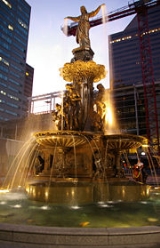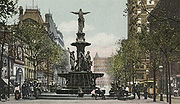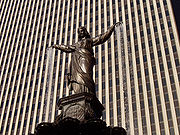
Tyler Davidson Fountain
Encyclopedia
The Tyler Davidson Fountain is a statue and fountain
located in Cincinnati
, Ohio
. It is regarded as the city's symbol and one of the area's most-visited attractions. It was dedicated in 1871 and is the centerpiece of Fountain Square
, a hardscape
plaza
at the corner of 5th and Vine Streets in the downtown area. It is surrounded by stores, hotels, restaurants and offices. Originally, and for more than 130 years, it was located in the center of 5th Street (Fountain Square's original configuration), immediately west of Walnut Street. In 2006, renovations were undertaken to Fountain Square, and the Tyler Davidson Fountain was temporarily removed. When reinstalled it was relocated to a much wider space near the north end of the reconfigured square, closer to the Fifth Third Bank
Building and away from street traffic. The fountain is turned-off for the winter months and turned-on again in time for the first home game of Major League Baseball's
Cincinnati Reds
, the oldest professional
baseball
team, in April.
 The 43 feet (13.1 m) fountain is cast in bronze
The 43 feet (13.1 m) fountain is cast in bronze
and sits on a granite
base. Its proper name is The Genius of Water and it features a 9 feet (2.7 m) bronze statue of a woman with outstretched hands out of which flow streams of water. Several smaller central human figures represent the practical uses of water and four outer figures with animals represent the pleasures of water. These are working drinking fountains from which passers-by can drink to this day. Panels on its lower part depict the industrial
uses of water.
The entire construct is made of approximately 24 tons of bronze and 85 tons of granite. It is estimated that 500 gallons of water flow through it every minute.
 After the death of his brother-in-law and business partner Tyler Davidson, Cincinnati businessman Henry Probasco went to Munich, Germany
After the death of his brother-in-law and business partner Tyler Davidson, Cincinnati businessman Henry Probasco went to Munich, Germany
in search of a suitable memorial to him. Many years before, artist August von Kreling
had collaborated with Ferdinand von Miller
at the Royal Bronze Foundry of Bavaria to design a fountain to rival the great fountains of Europe but which would glorify mankind rather than fanciful creatures and mythic
deities
. When Miller could find no patron to sponsor the fountain, the designs languished until Probasco came to him with an interest in a similar theme. Probasco requested the addition of four figures with animals that would act as drinking fountains, which Miller's sons Ferdinand
and Fritz designed. The original miniature model is now located in the Cincinnati Art Museum
.
 The fountain was cast in separate sections at the foundry and shipped to Cincinnati for assembly. Probasco requested that the City of Cincinnati remove the dilapidated market along 5th Street between Vine and Walnut Streets for the fountain. In its place an esplanade bisecting 5th Street was built, the designer was architect William Tinsley. Tinsley had also designed the Henry Probasco House in the suburb of Clifton
The fountain was cast in separate sections at the foundry and shipped to Cincinnati for assembly. Probasco requested that the City of Cincinnati remove the dilapidated market along 5th Street between Vine and Walnut Streets for the fountain. In its place an esplanade bisecting 5th Street was built, the designer was architect William Tinsley. Tinsley had also designed the Henry Probasco House in the suburb of Clifton
. The esplanade made the fountain easily visible to anyone traveling by. Miller traveled to Cincinnati for the dedication ceremony, which took place on October 6, 1871, it is estimated that 20,000 people were present. Miller and Von Kreling enjoyed a degree of celebrity in the city.
The fountain originally faced east, toward Europe, where much of Cincinnati's population originated. When Fountain Square
was redone in the late 1960s, the fountain was realigned to face west. With the newest rendition of Fountain Square, the fountain faces to south since it is on the edge of the square.
The fountain was renovated for the first time in 1970 for a celebration of its centennial. The Fountain Square plaza was also redesigned for better traffic flow, and the fountain was moved and turned to face west rather than east. Additional repairs and another refurbishing project was undertaken in 1999. In 2005, as part of Fountain Square's revitalization, the city decided to move the entire fountain to the center of Fountain Square. The estimated cost was approximately $42 million. The city was responsible for $4 million. During the renovation the fountain was on display at the Cincinnati Art Museum
.
Fountain Square reopened on October 14, 2006 with an elaborate ceremony that included different stages for multiple bands, food, beer and fireworks
. The fountain continues to be a backdrop for various cultural events in Cincinnati: movie nights, game shows, and the ice rink
which opens in the winter.
The fountain is most familiar to non-Cincinnati residents for being featured in the opening credits (at its former location) of the television series WKRP in Cincinnati
.
Fountain
A fountain is a piece of architecture which pours water into a basin or jets it into the air either to supply drinking water or for decorative or dramatic effect....
located in Cincinnati
Cincinnati, Ohio
Cincinnati is a city in the U.S. state of Ohio. Cincinnati is the county seat of Hamilton County. Settled in 1788, the city is located to north of the Ohio River at the Ohio-Kentucky border, near Indiana. The population within city limits is 296,943 according to the 2010 census, making it Ohio's...
, Ohio
Ohio
Ohio is a Midwestern state in the United States. The 34th largest state by area in the U.S.,it is the 7th‑most populous with over 11.5 million residents, containing several major American cities and seven metropolitan areas with populations of 500,000 or more.The state's capital is Columbus...
. It is regarded as the city's symbol and one of the area's most-visited attractions. It was dedicated in 1871 and is the centerpiece of Fountain Square
Fountain Square, Cincinnati
Fountain Square is a city square in Cincinnati. Founded in 1871, it was renovated in 1971 and 2005 and currently features many shops, restaurants, hotels, and offices.- History :...
, a hardscape
Hardscape
Hardscape, in the practice of landscaping, refers to the paved areas like streets & sidewalks, large business complexes & housing developments, and other industrial areas where the upper soil profile is no longer exposed to the actual surface of the Earth...
plaza
Plaza
Plaza is a Spanish word related to "field" which describes an open urban public space, such as a city square. All through Spanish America, the plaza mayor of each center of administration held three closely related institutions: the cathedral, the cabildo or administrative center, which might be...
at the corner of 5th and Vine Streets in the downtown area. It is surrounded by stores, hotels, restaurants and offices. Originally, and for more than 130 years, it was located in the center of 5th Street (Fountain Square's original configuration), immediately west of Walnut Street. In 2006, renovations were undertaken to Fountain Square, and the Tyler Davidson Fountain was temporarily removed. When reinstalled it was relocated to a much wider space near the north end of the reconfigured square, closer to the Fifth Third Bank
Fifth Third Bank
Fifth Third Bank is a U.S. regional banking corporation, headquartered in Cincinnati, Ohio and is the principal subsidiary of holding company Fifth Third Bancorp ....
Building and away from street traffic. The fountain is turned-off for the winter months and turned-on again in time for the first home game of Major League Baseball's
Major League Baseball
Major League Baseball is the highest level of professional baseball in the United States and Canada, consisting of teams that play in the National League and the American League...
Cincinnati Reds
Cincinnati Reds
The Cincinnati Reds are a Major League Baseball team based in Cincinnati, Ohio. They are members of the National League Central Division. The club was established in 1882 as a charter member of the American Association and joined the National League in 1890....
, the oldest professional
Professional baseball
Baseball is a team sport which is played by several professional leagues throughout the world. In these leagues, and associated farm teams, players are selected for their talents and are paid to play for a specific team or club system....
baseball
Baseball
Baseball is a bat-and-ball sport played between two teams of nine players each. The aim is to score runs by hitting a thrown ball with a bat and touching a series of four bases arranged at the corners of a ninety-foot diamond...
team, in April.
Characteristics

Bronze
Bronze is a metal alloy consisting primarily of copper, usually with tin as the main additive. It is hard and brittle, and it was particularly significant in antiquity, so much so that the Bronze Age was named after the metal...
and sits on a granite
Granite
Granite is a common and widely occurring type of intrusive, felsic, igneous rock. Granite usually has a medium- to coarse-grained texture. Occasionally some individual crystals are larger than the groundmass, in which case the texture is known as porphyritic. A granitic rock with a porphyritic...
base. Its proper name is The Genius of Water and it features a 9 feet (2.7 m) bronze statue of a woman with outstretched hands out of which flow streams of water. Several smaller central human figures represent the practical uses of water and four outer figures with animals represent the pleasures of water. These are working drinking fountains from which passers-by can drink to this day. Panels on its lower part depict the industrial
Industry
Industry refers to the production of an economic good or service within an economy.-Industrial sectors:There are four key industrial economic sectors: the primary sector, largely raw material extraction industries such as mining and farming; the secondary sector, involving refining, construction,...
uses of water.
The entire construct is made of approximately 24 tons of bronze and 85 tons of granite. It is estimated that 500 gallons of water flow through it every minute.
History

Germany
Germany , officially the Federal Republic of Germany , is a federal parliamentary republic in Europe. The country consists of 16 states while the capital and largest city is Berlin. Germany covers an area of 357,021 km2 and has a largely temperate seasonal climate...
in search of a suitable memorial to him. Many years before, artist August von Kreling
August von Kreling
August von Kreling German sculptor born in Osnabrück. He studied with Cornelius and in 1853, became director of the Academy of Fine Arts Nuremberg...
had collaborated with Ferdinand von Miller
Ferdinand Von Miller
Ferdinand von Miller was a German artisan who is noted for his furtherance of bronze founding.-Biography:Von Miller was born in Fürstenfeldbruck....
at the Royal Bronze Foundry of Bavaria to design a fountain to rival the great fountains of Europe but which would glorify mankind rather than fanciful creatures and mythic
Mythology
The term mythology can refer either to the study of myths, or to a body or collection of myths. As examples, comparative mythology is the study of connections between myths from different cultures, whereas Greek mythology is the body of myths from ancient Greece...
deities
Deity
A deity is a recognized preternatural or supernatural immortal being, who may be thought of as holy, divine, or sacred, held in high regard, and respected by believers....
. When Miller could find no patron to sponsor the fountain, the designs languished until Probasco came to him with an interest in a similar theme. Probasco requested the addition of four figures with animals that would act as drinking fountains, which Miller's sons Ferdinand
Ferdinand Freiherr von Miller
Ferdinand Miller, from 1875 von Miller and from 1912 Freiherr von Miller was a ore caster, sculptor and direktor of the Academy of Fine Arts, Munich...
and Fritz designed. The original miniature model is now located in the Cincinnati Art Museum
Cincinnati Art Museum
The Cincinnati Art Museum is one of the oldest art museums in the United States. Founded in 1881, it was the first purpose-built art museum west of the Alleghenies. Its collection of over 60,000 works make it one of the most comprehensive collections in the Midwest.Museum founders debated locating...
.

Clifton, Cincinnati, Ohio
Clifton, incorporated as a village in 1850, is now a neighborhood in the north central part of Cincinnati, Ohio, United States. The area includes the Ludlow Avenue Shopping and Dining District. Clifton is situated around Clifton Avenue, north of Dixmyth Avenue, approximately three miles north of...
. The esplanade made the fountain easily visible to anyone traveling by. Miller traveled to Cincinnati for the dedication ceremony, which took place on October 6, 1871, it is estimated that 20,000 people were present. Miller and Von Kreling enjoyed a degree of celebrity in the city.
The fountain originally faced east, toward Europe, where much of Cincinnati's population originated. When Fountain Square
Fountain Square, Cincinnati
Fountain Square is a city square in Cincinnati. Founded in 1871, it was renovated in 1971 and 2005 and currently features many shops, restaurants, hotels, and offices.- History :...
was redone in the late 1960s, the fountain was realigned to face west. With the newest rendition of Fountain Square, the fountain faces to south since it is on the edge of the square.
The fountain was renovated for the first time in 1970 for a celebration of its centennial. The Fountain Square plaza was also redesigned for better traffic flow, and the fountain was moved and turned to face west rather than east. Additional repairs and another refurbishing project was undertaken in 1999. In 2005, as part of Fountain Square's revitalization, the city decided to move the entire fountain to the center of Fountain Square. The estimated cost was approximately $42 million. The city was responsible for $4 million. During the renovation the fountain was on display at the Cincinnati Art Museum
Cincinnati Art Museum
The Cincinnati Art Museum is one of the oldest art museums in the United States. Founded in 1881, it was the first purpose-built art museum west of the Alleghenies. Its collection of over 60,000 works make it one of the most comprehensive collections in the Midwest.Museum founders debated locating...
.
Fountain Square reopened on October 14, 2006 with an elaborate ceremony that included different stages for multiple bands, food, beer and fireworks
Fireworks
Fireworks are a class of explosive pyrotechnic devices used for aesthetic and entertainment purposes. The most common use of a firework is as part of a fireworks display. A fireworks event is a display of the effects produced by firework devices...
. The fountain continues to be a backdrop for various cultural events in Cincinnati: movie nights, game shows, and the ice rink
Ice rink
An ice rink is a frozen body of water and/or hardened chemicals where people can skate or play winter sports. Besides recreational ice skating, some of its uses include ice hockey, figure skating and curling as well as exhibitions, contests and ice shows...
which opens in the winter.
The fountain is most familiar to non-Cincinnati residents for being featured in the opening credits (at its former location) of the television series WKRP in Cincinnati
WKRP in Cincinnati
WKRP in Cincinnati is an American situation comedy that featured the misadventures of the staff of a struggling fictional radio station in Cincinnati, Ohio. The show was created by Hugh Wilson and was based upon his experiences working in advertising sales at Top 40 radio station WQXI in Atlanta...
.

